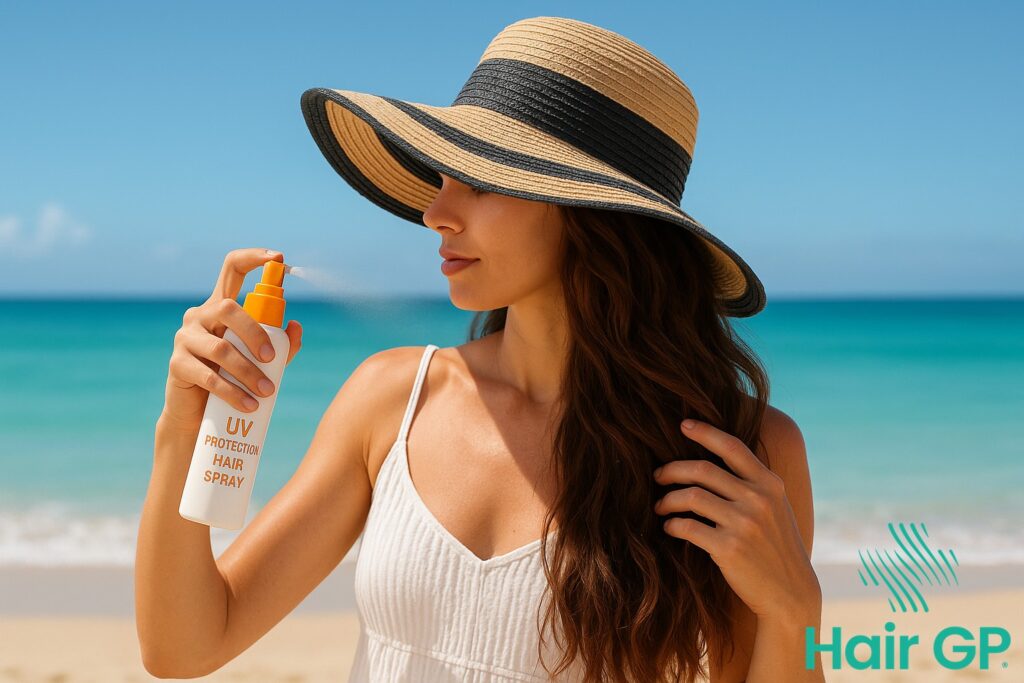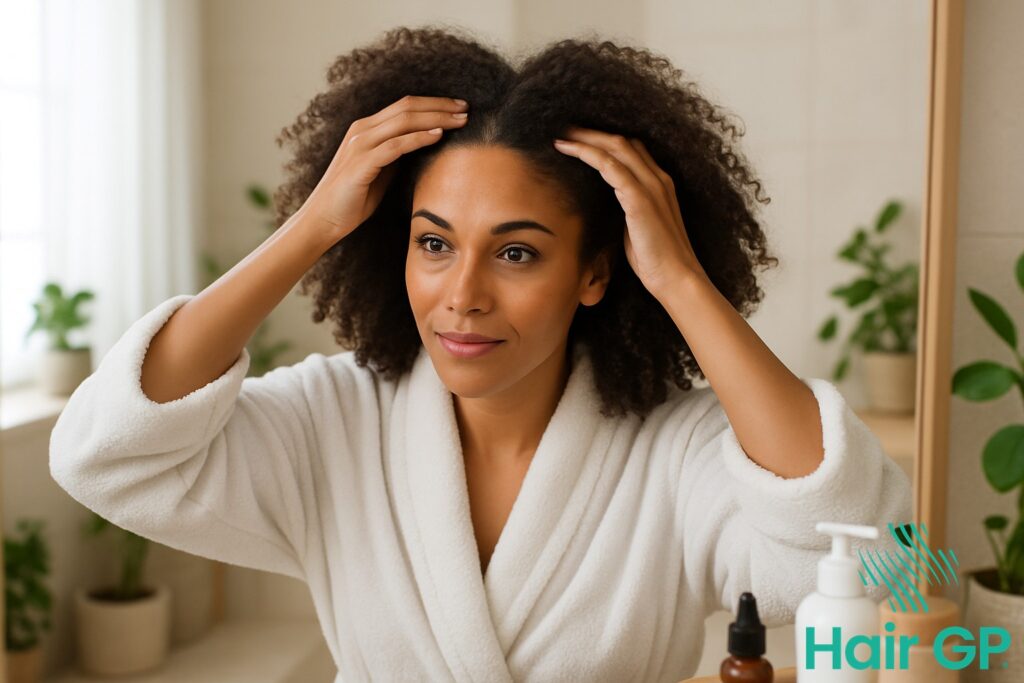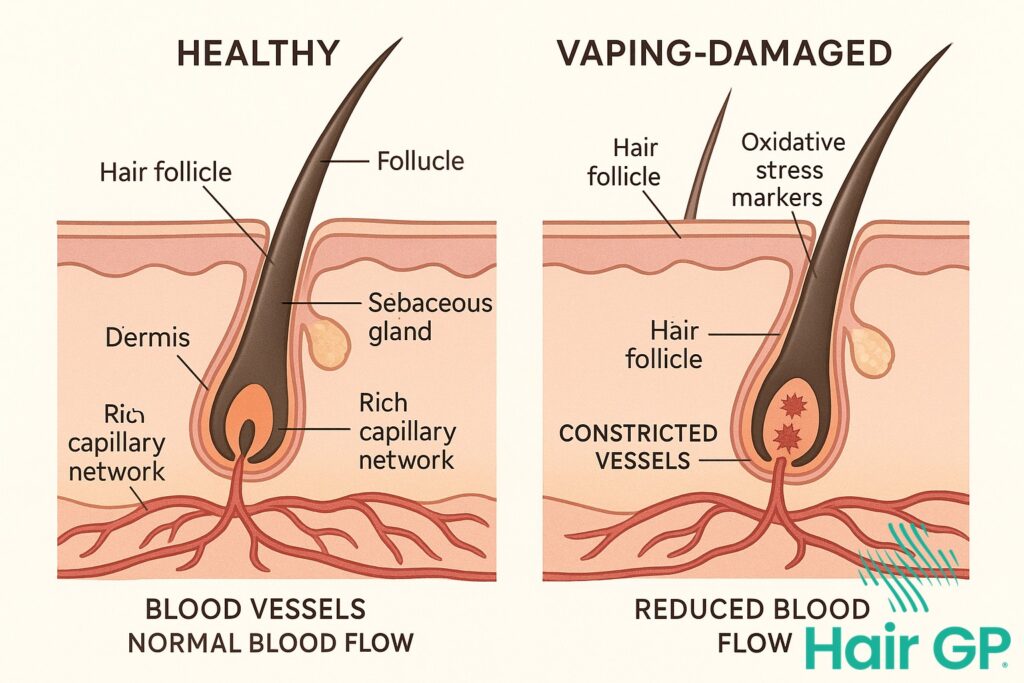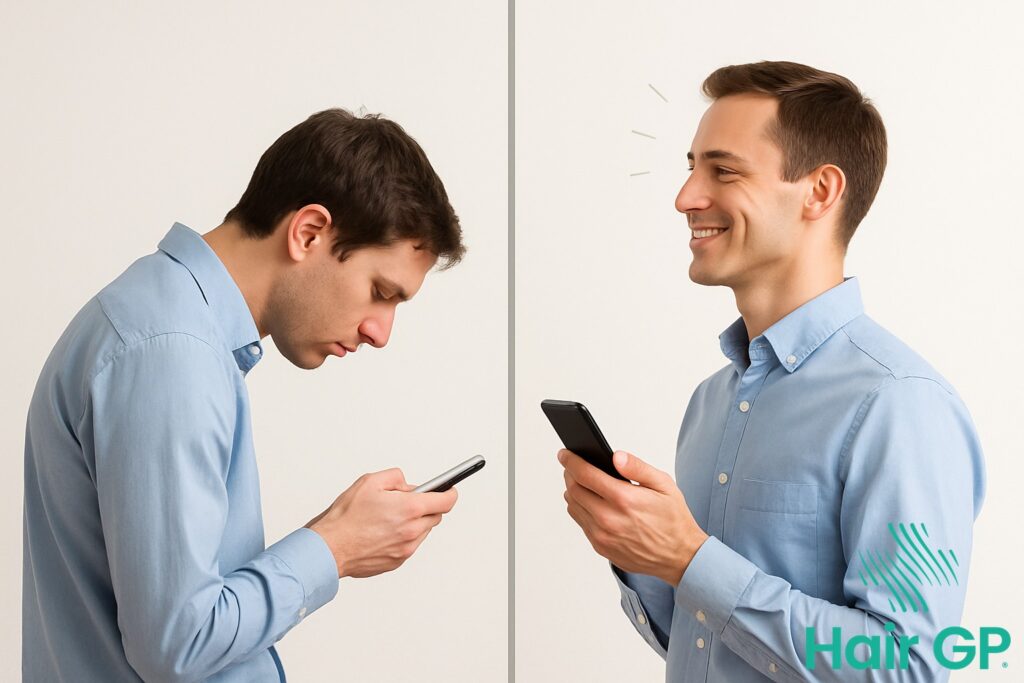Introduction
As the summer sun brightens our days, many of us eagerly abandon our hairdryers in favour of natural air drying. Yet this seemingly healthy choice might be causing more hair damage than we realise. Whilst we’re increasingly aware of how the sun affects our skin, the impact of UV damage on our hair often goes unnoticed until the telltale signs appear: brittle strands, faded colour, and that unmistakable straw-like texture.
The truth is, prolonged sun exposure can inflict serious harm on your hair’s structure without any heat styling tools involved. UV rays penetrate deep into hair shafts, breaking down essential proteins and stripping away natural moisture – creating damage that rivals or even exceeds what your hairdryer might cause. This comprehensive guide will help you understand the science behind how UV radiation affects your hair health, from the molecular level to the visible symptoms you might already be experiencing.
We’ll explore why air drying in direct sunlight can sometimes prove more damaging than controlled blow drying, reveal the most effective protection strategies to shield your hair from harmful rays, and share proven repair methods for hair that’s already suffered sun damage. Along the way, we’ll separate fact from fiction by addressing common misconceptions about summer hair care. Whether you’re dealing with existing damage or looking to prevent it, this guide provides practical, evidence-based solutions to maintain healthy, vibrant hair throughout the summer months and beyond.
Key Takeaways – TL/DR
- UV rays penetrate hair cuticles causing protein breakdown and moisture loss, leading to dry, brittle hair
- Sun damage differs from heat styling damage by affecting hair’s internal structure and natural pigments
- Hair needs SPF protection just like skin, with specialized hair sunscreens and protective products
- Air drying in direct sunlight can be more damaging than controlled blow drying indoors
- Different hair types show varying vulnerability to sun damage, with fine and color-treated hair most at risk
Understanding How UV Rays Damage Hair Structure
When the sun’s rays penetrate our hair strands, they initiate a complex cascade of molecular damage that goes far beyond surface-level effects. Unlike the temporary stress from heat styling, UV rays cause progressive deterioration at the structural level, breaking down essential proteins and compromising the integrity of each hair strand from within.
The Science Behind UV-Induced Protein Breakdown
UV radiation, particularly UVB rays, triggers a destructive process called photooxidation within the hair shaft . This mechanism generates free radicals that attack keratin, the primary structural protein comprising 65-95% of our hair. As these unstable molecules multiply, they cleave the disulphide bonds that give hair its strength and elasticity. The damage extends beyond keratin to affect melanin pigments and lipids within the hair cuticles, leading to colour fading and moisture loss. Research demonstrates that prolonged UV exposure can reduce hair’s tensile strength by up to 40%, making strands increasingly prone to breakage [1].
Comparing Sun Damage vs Heat Styling Damage
Whilst both sun damage and heat styling harm our hair, their mechanisms differ significantly. Heat damage occurs immediately through rapid moisture evaporation and protein denaturation at temperatures above 150°C. In contrast, UV damage accumulates gradually, penetrating deeper into the hair cortex over repeated exposures. Sun damage proves particularly insidious because it continues even after exposure ends, as free radicals persist within the hair structure. Recovery also differs markedly: whilst heat-damaged hair can improve with protein treatments and reduced styling, UV-damaged hair often requires cutting away affected sections, as the photochemical changes are largely irreversible.
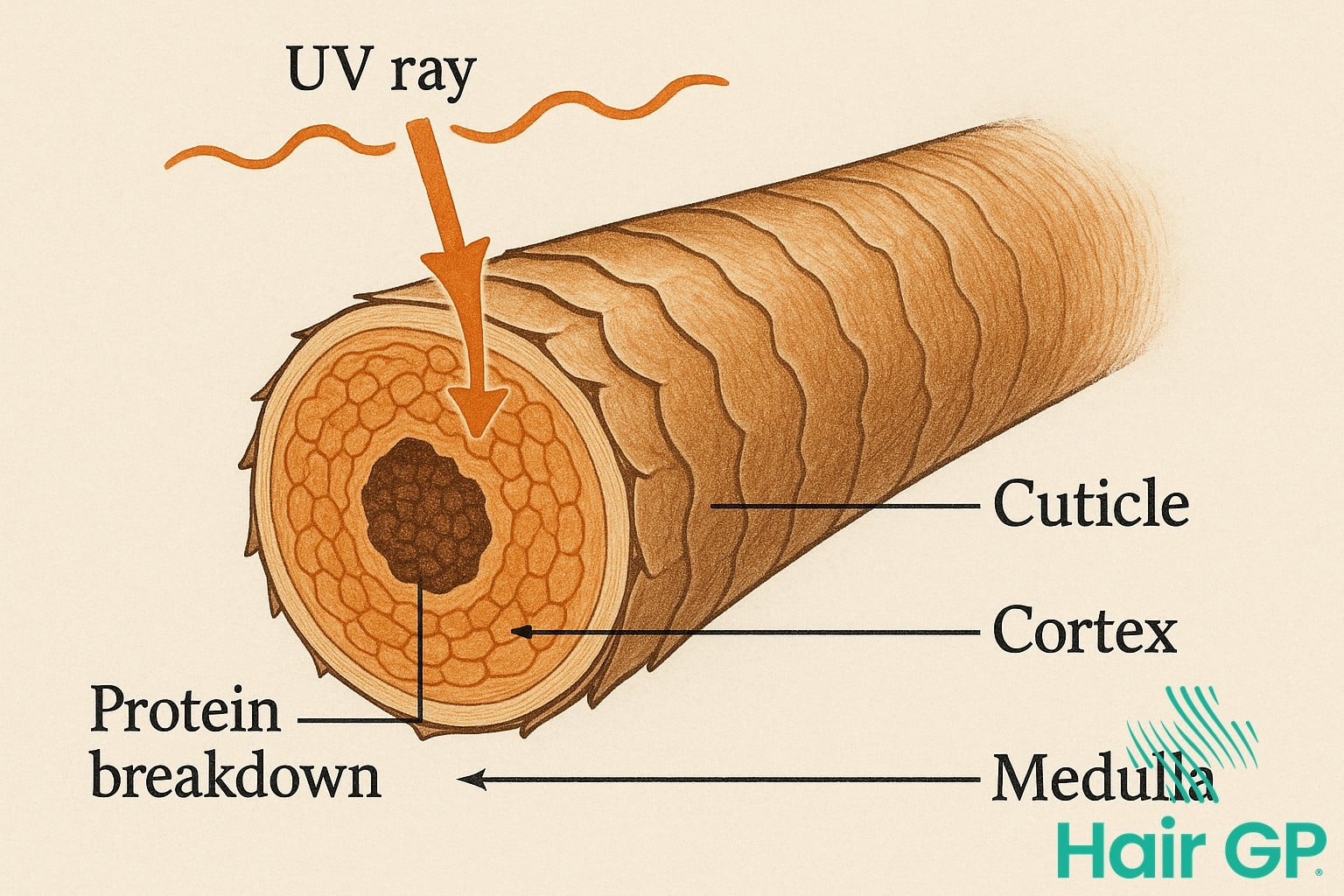
Signs Your Hair Has Sun Damage
Recognising the signs of sun-damaged hair is crucial for assessing your hair’s health and determining the right treatment approach. From subtle texture changes to obvious colour shifts, UV damage manifests in various ways that often worsen without proper intervention.
Physical Signs of UV Damage
The most noticeable indicators of sun-damaged hair begin with texture transformation. Your once-smooth strands may develop a rough, coarse feel that resists styling efforts. This damaged hair typically loses its natural shine, appearing dull and lifeless even after washing. You’ll likely notice increased tangling, particularly at the ends where split ends become more prevalent. The hair shaft weakens, leading to brittle hair that snaps easily during brushing. Colour changes are particularly telling – natural hair may develop brassy undertones, whilst colour-treated locks fade unevenly, creating patchy, washed-out hues.
How Different Hair Types Show Sun Damage
Fine hair suffers disproportionately from UV exposure, becoming noticeably thinner and more prone to hair loss at the crown. Curly textures experience extreme dry hair conditions, with curl patterns becoming undefined and increasingly frizzy. Chemically processed or colour-treated hair shows the most dramatic deterioration, with highlights turning yellow and lowlights appearing muddy. Darker hair may develop reddish tints, whilst blonde hair often turns brassy or greenish from combined sun and chlorine exposure.
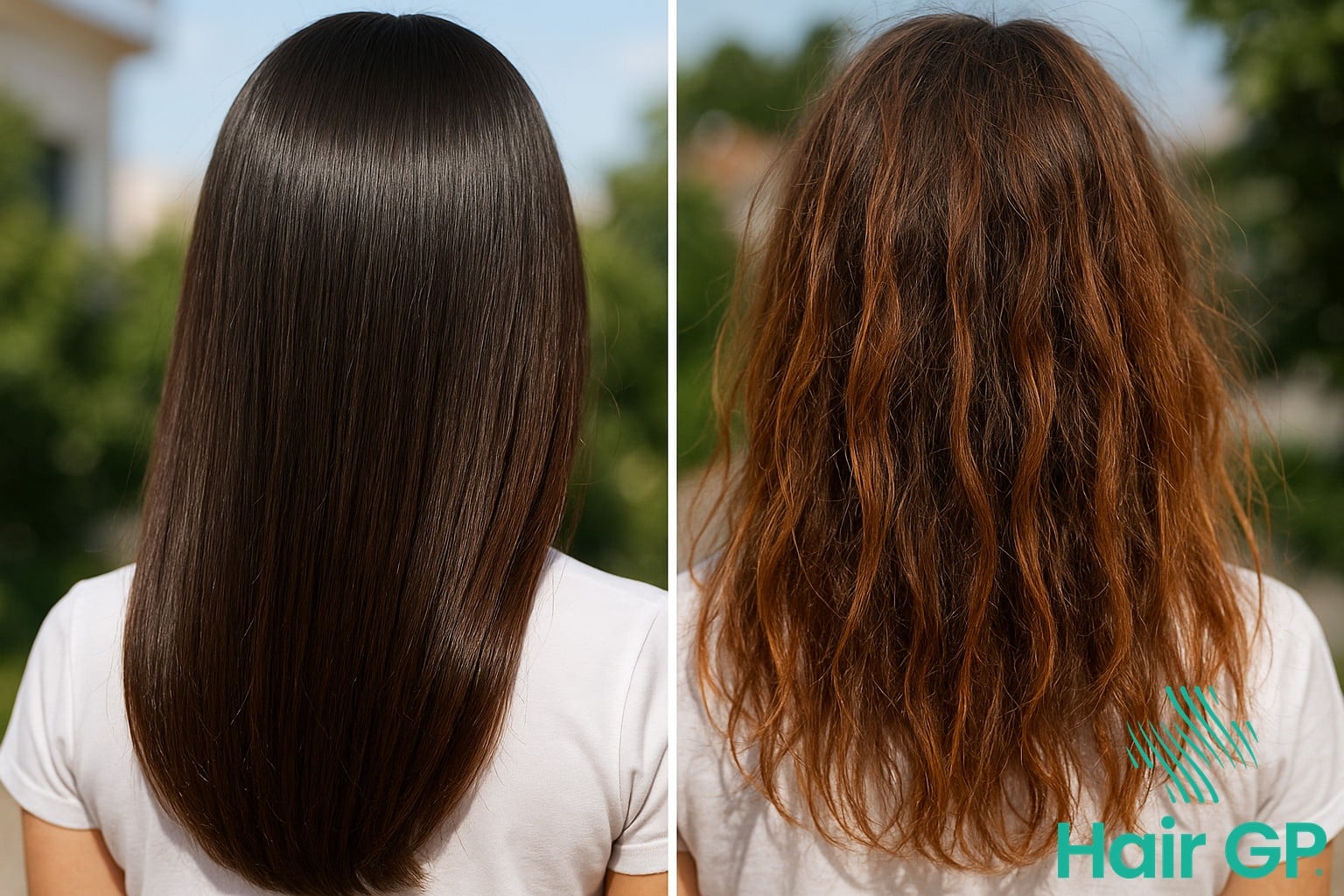
Why Air Drying in the Sun Can Be Worse Than Blow Drying
Whilst many believe that air drying is inherently gentler than using a hair dryer, research reveals a more complex reality. When wet hair is exposed to direct sunlight during air drying, the combination of moisture and UV radiation can create conditions more damaging than controlled heat styling [2]. The prolonged sun exposure required for complete drying—often exceeding two hours for medium to long hair—subjects strands to sustained UV damage that penetrates deep into the hair shaft.
This extended exposure creates uneven drying patterns, with outer layers becoming brittle whilst inner sections remain damp, leading to structural inconsistencies throughout the hair fibre. The cumulative effects include increased porosity, protein degradation, and colour fading that surpasses damage from brief, controlled blow drying sessions [3].
In contrast, proper blow drying techniques using moderate heat settings and protective products can minimise damage whilst reducing overall exposure time to just 10-15 minutes. The controlled environment allows for even moisture removal and prevents the prolonged vulnerability that occurs when wet hair bakes under direct sunlight for hours.
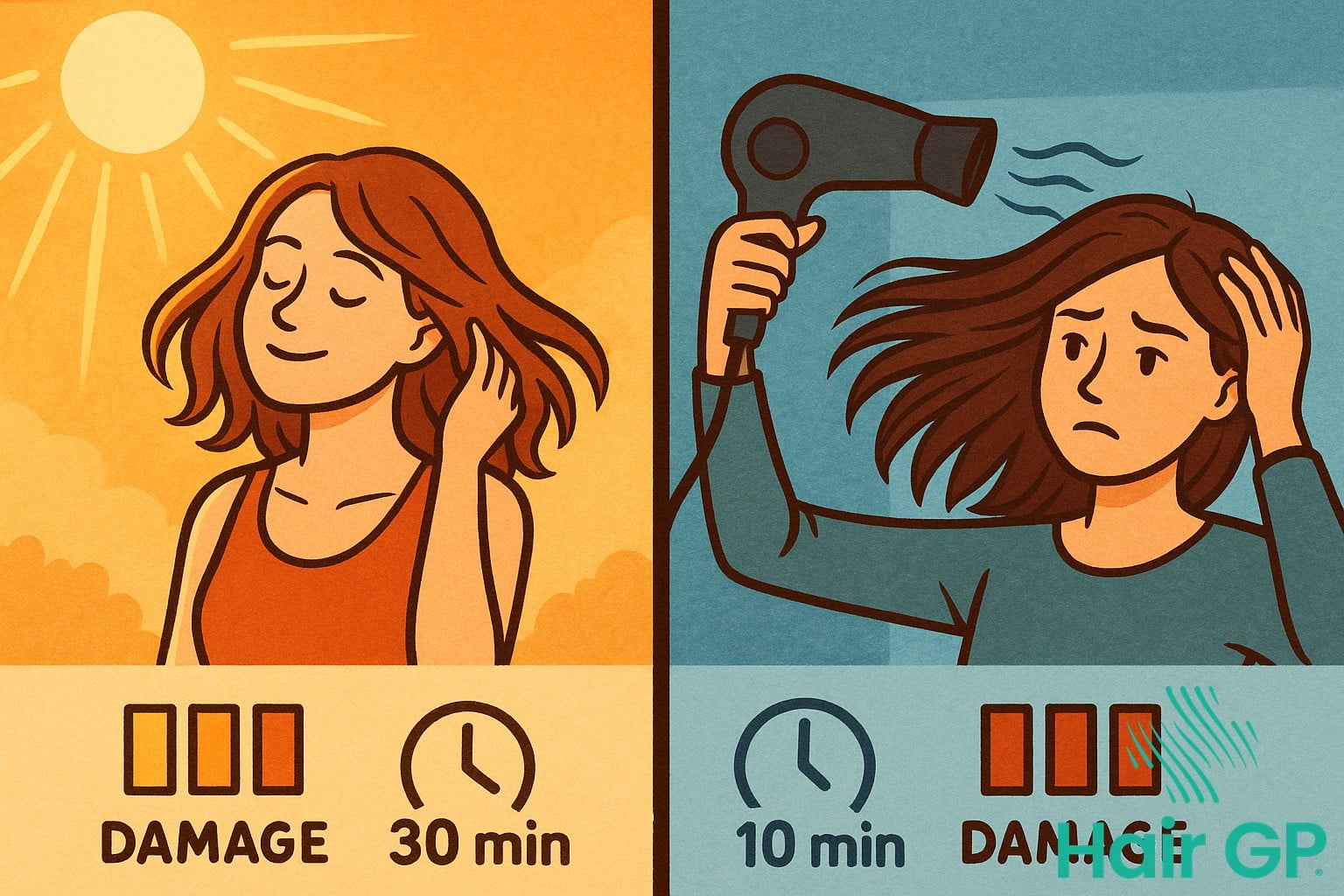
Essential Sun Protection Strategies for Hair
Implementing effective sun protection strategies for your hair care routine during summer heat is essential for maintaining healthy, vibrant locks. These practical approaches combine physical barriers with specialised products to shield your strands from harmful UV rays whilst enjoying outdoor activities.
Physical Barriers and Protective Accessories
The simplest method to protect hair from UV damage involves physical barriers that create shade and reduce direct exposure. Wide-brimmed hats offer comprehensive coverage, protecting not only your scalp but also the delicate hair around your face and neck. UV-protective scarves provide versatile protection whilst adding style to your summer wardrobe. Strategic hairstyles like braids, buns, or updos minimise exposed surface area, reducing the amount of hair vulnerable to sun damage. These protective styles also help prevent tangling and breakage during outdoor activities.
Hair Sunscreens and UV-Protective Products
Specialised hair sunscreens have emerged as essential tools for comprehensive UV protection. SPF hair sprays containing UV filters can reduce colour fading by up to 40% when applied correctly[1]. Leave-in conditioners with built-in UV filters provide dual benefits, offering sun protection whilst maintaining moisture levels throughout the day. For optimal protection, apply these products generously to dry hair before sun exposure, focusing on the outer layers and ends. Reapplication every two hours ensures continuous protection, particularly after swimming or excessive sweating. Look for products labelled with broad-spectrum protection to guard against both UVA and UVB rays.
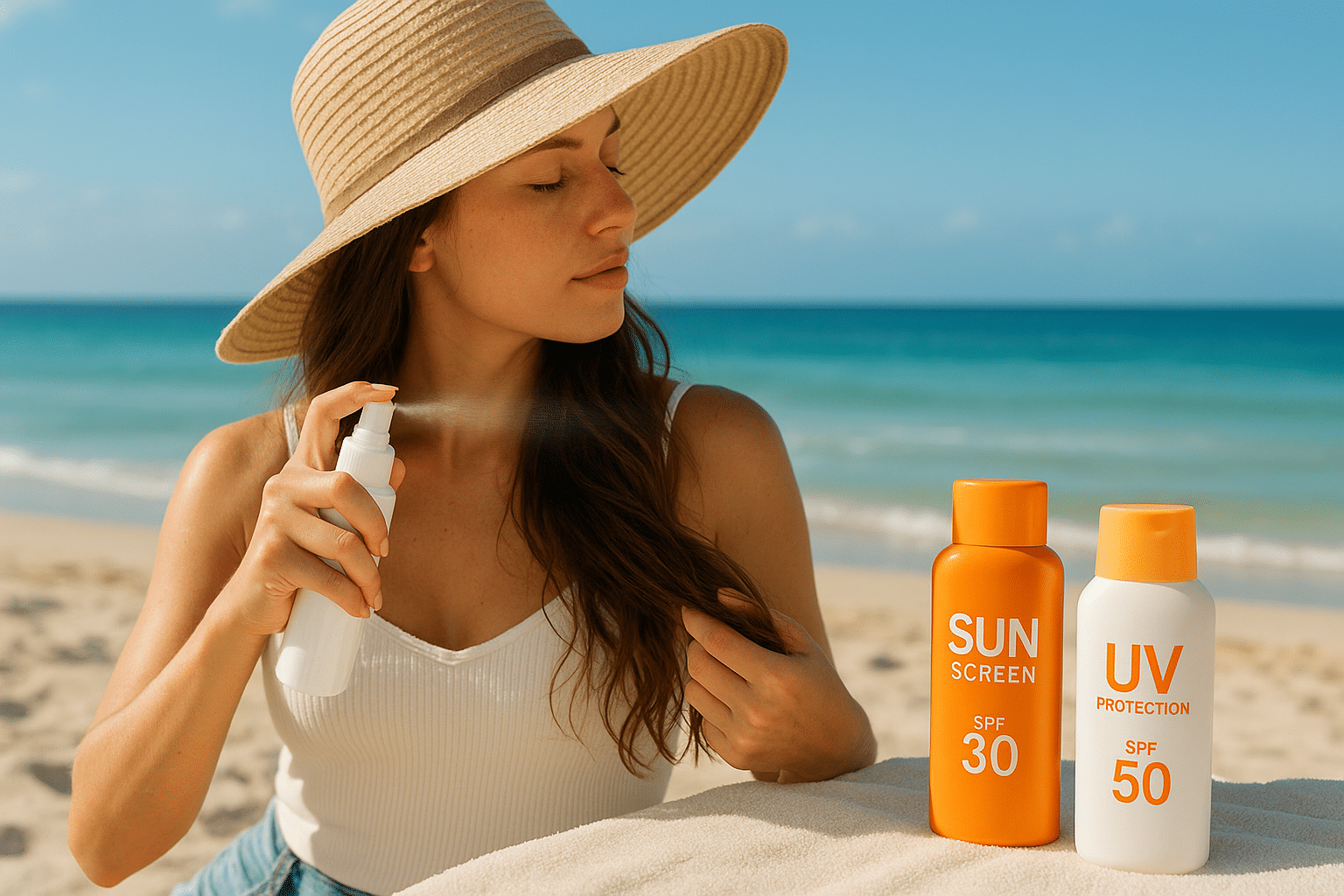
Repairing and Treating Sun-Damaged Hair
Restoring sun-damaged hair requires a comprehensive approach combining intensive moisture treatments with strategic trimming. The right combination of hair care products and professional interventions can help reverse UV damage and restore your hair’s natural vitality.
Deep Conditioning and Moisture Restoration
Intensive hydration forms the cornerstone of treating damaged hair from UV exposure. Weekly hair mask applications provide deep nourishment, penetrating the hair shaft to replenish lost moisture. Choose rich, creamy formulations containing ingredients like shea butter or argan oil for maximum benefit. Overnight treatments amplify results—apply a generous amount of conditioner before bed, covering with a silk cap to prevent pillow transfer. For daily maintenance, a quality leave in conditioner acts as a protective barrier whilst continuously hydrating strands. Moisture-sealing techniques, such as the LOC method (liquid, oil, cream), help lock hydration into the hair cuticle for lasting results.
When to Trim and Professional Treatments
Regular trimming every 6-8 weeks removes split ends before damage travels up the hair shaft. Professional salon treatments like Olaplex or keratin reconstructors can dramatically improve hair structure. Recovery timelines vary—minor damage may improve within 4-6 weeks of consistent hair care, whilst severe cases require 3-6 months of dedicated treatment. Patience combined with the right approach yields remarkable results.
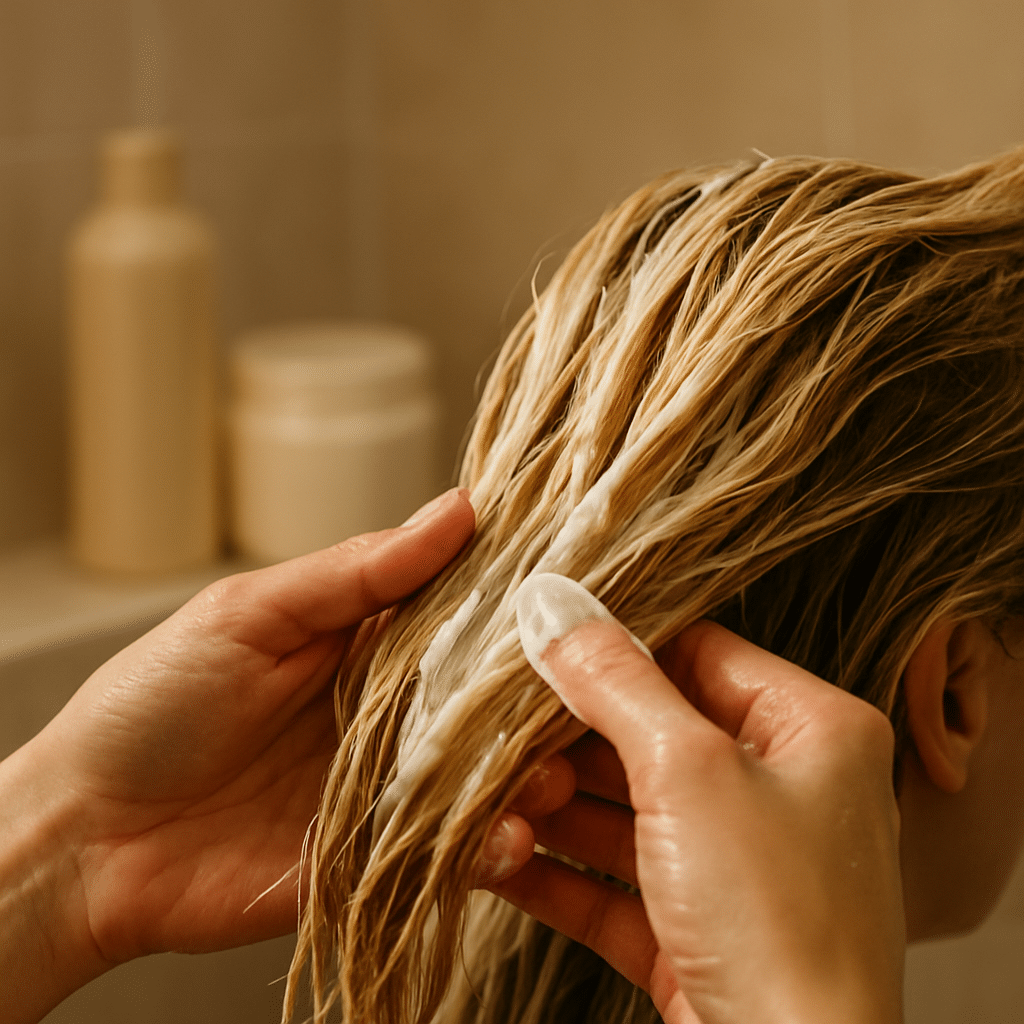
Common Myths About Sun and Hair Care
Despite widespread beliefs about summer hair care, many popular notions about sun exposure and hair health lack scientific backing. One persistent myth suggests that hair wet from swimming or showering cannot experience sunburn, yet research demonstrates that moisture actually intensifies UV penetration into the hair shaft . Similarly, the romantic notion that natural sun lightening creates healthier, glossy hair proves misleading—UV-induced bleaching breaks down melanin and protein structures, causing brittleness rather than shine.
Another common misconception involves hair type and sun protection. Whilst darker hair contains more melanin, providing some UV filtration, this protection remains limited and insufficient for preventing photodamage during extended summer exposure [4]. The belief that certain hair textures are immune to sun damage overlooks the universal vulnerability of keratin proteins to UV degradation, regardless of curl pattern or thickness [5].
Conclusion
The summer sun poses a significant threat to your hair health, causing damage that extends far beyond what any heat styling tool could achieve. Throughout this article, we’ve explored how UV radiation and environmental heat work together to break down your hair’s natural structure, leading to dryness, brittleness, and loss of vitality.
Understanding the science behind hair damage empowers you to take proactive steps in protecting your tresses. Implementing comprehensive sun protection strategies—from specialised hair sunscreens to physical barriers like hats and scarves—creates a defensive shield against harmful rays. These preventive measures are far more effective than attempting to repair damage after it occurs.
Remember, maintaining glossy hair throughout summer isn’t about avoiding the outdoors; it’s about being prepared. Consistent protection habits, combined with proper hydration and nourishment, will preserve your hair’s natural lustre and strength. By treating your hair with the same care you give your skin, you’ll enjoy healthy, vibrant locks that withstand summer’s challenges whilst maintaining their beauty year-round. Make sun protection an integral part of your hair care routine, and your future self will thank you.
Frequently Asked Questions
Yes, up to 80% of UV rays can penetrate clouds, meaning your hair is still at risk of sun damage even on overcast days. It’s important to maintain sun protection habits regardless of cloud cover.
Dry shampoo can be used after sun exposure, but it shouldn’t replace proper cleansing and conditioning. Sun-exposed hair needs moisture, so follow up with hydrating treatments after using dry shampoo.
Both cause damage differently. Straighteners cause immediate thermal damage at high temperatures, while sun damage is cumulative and affects hair structure over time. Using heat protectants and limiting both exposures is ideal.
Sun damage can begin immediately but visible signs typically appear after 2-3 weeks of regular exposure. Symptoms like dryness, brittleness, and color fading progressively worsen with continued unprotected sun exposure.
Yes, prolonged sun exposure can cause scalp sunburn leading to itchiness, flaking, and irritation. The scalp needs sun protection just like skin, especially along parts and areas with thinning hair.
References
- Gao T, Bedell A. Ultraviolet damage on natural gray hair and its photoprotection. J Cosmet Sci. 2001. PMID: 11382847
- Lee Y, Kim YD, Hyun HJ, Pi LQ, Jin X, Lee WS. Hair shaft damage from heat and drying time of hair dryer. Ann Dermatol. 2011. PMID: 22148012
- Gavazzoni Dias MF. Hair cosmetics: an overview. Int J Trichology. 2015. PMID: 25878443
- Fujimoto K, Nishimura M, Fukui Y. Core-shell Particle Embedding into Human Hair: A Novel Approach for Surface Modification and Long-Lasting Hair Coloration. ACS Omega. 2025. PMID: 40454046
- Fernández E, Barba C, Alonso C, Martí M, Parra JL, Coderch L. Photodamage determination of human hair. J Photochem Photobiol B. 2012. PMID: 22119660

